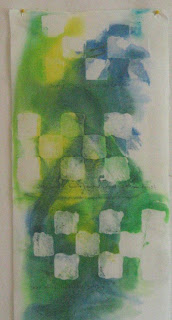From top to bottom, the resists used were: Batik-EZ, Jacquard water-based resist, and soy wax. Once I applied the resisits and let them dry completely, I brushed a little water over the fabric and immediately followed with dye-na-flow, using a foam brush to apply. Then I misted a little with water, and allowed the piece to air dry completely. Once it was dry, I rinsed to remove the Batik-EZ and water-based resist, then dried again. And finally, I used a hot iron and newspaper to remove the soy wax, then heat set the dy-na-flow.
Comments about each resist - Batik-Ez was fairly sticky to apply. I used a stencil and stencil brush, then washed all in hot soapy water. When the brush was dry, it felt stiff, so I washed again after soaking in water.
Jacquard water-based resist separates and needed to be stirred a good deal to get it mixed well before I applied it. The resist felt like it was greasy to the touch, and I had to wash off the brush and stencil quite a bit to remove the residue.
Soy wax - I am used to using this as a resist, but noticed that the shapes I got were less sharp than with the other 2 resists. And of course, there was the issue of having to iron it out in order to avoid washing away some of the dy-na-flow. My main purpose for this test was to see if i could achieve comparable results with Batik-EZ and/or Jacquard water-based resist to what I am used to getting with soy wax, and I am happy to announce that the results were good from all 3. Ranking by ease of use, I think Batik-EZ was slightly easier to use than the Jacquard, and more convenient than the soy wax. But in a pinch, I think any of the 3 would get the job done. A bonus of the first 2 is that they are easier to remove than the soy wax.
I plan to do more testing using different application methods, and will post results as I get them.

No comments:
Post a Comment